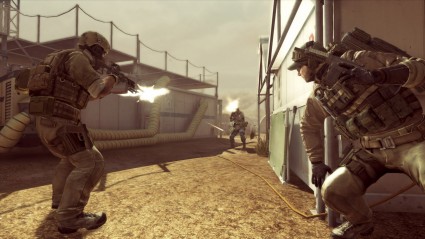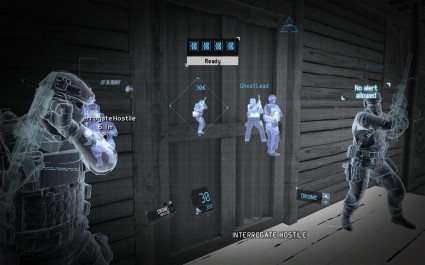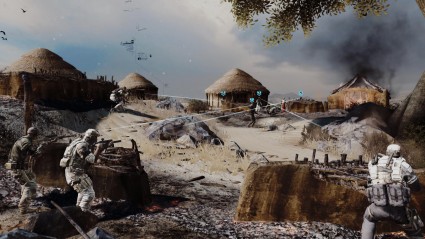Reviews
Ghost Recon: Future Soldier
June 18, 2012, Author: Andy Corrigan
Despite a lot of the gaming community being divided on the merits of the Ghost Recon series, with the likes of Halo and Call of Duty leading the way for shooters, I can safely say that Ubisoft’s series has been a firm favourite with me since the very beginning. It was my first taste of a punishing, more realistic type of shooter. One shot was enough to down you easily and brutally, and the use of camouflage and your available teammates was essential to succeed.
Although the game took a step towards the future in Ghost Recon: Advanced Warfighter and its direct sequel, the core principles of the game remained intact. Slow burning, tactical combat ensued, and it was gloriously fun.
Ghost Recon: Future Soldier is the name of Ubisoft’s next foray into the Tom Clancy’s universe, and there is change afoot after a five year hiatus. More change than the series has ever seen before, I might add, but is that change a good thing?
Ghostly activity
Ghosts can be killed it seems, as a Ghost unit falls victim to a dirty bomb while trying to prevent weapons sales in Nicaragua. Of course, the USA is furious. Former Ghost, Major Scott Mitchell dispatches a new team of four, dubbed Hunter Team, to Bolivia to follow up on a lead as to where the lethal explosive came from. Of course, they’re scratching the surface on a far greater conspiracy.
While fairly standard of modern-day military shooters, I have to say that I really enjoyed the plot here a lot more than in previous Ghost Recon games, where the story was always just an excuse to put players in different war scenarios. It’s less dry here, and although there have been a few artistic liberties taken with military accuracy, it ties it all together a bit better than usual.

Stealth is still a key, but this is very much a different Ghost Recon experience.
Tactics vs. intensity
In gameplay, Ghost Recon: Future Solider represents everything that the series has never been before. It’s quick, unashamedly brash and a hell of a lot more forgiving that its forebears. Even for series-long fans like me, the controls are uncharacteristically smooth, handling like a standard, non-tactical third-person shooter, such as Gears of War. This is a comparison that rears its head once more when you realise that sprinting and taking cover both behave technically and visually similar to Epic’s franchise. It does feature the same nifty cover-to-cover feature from Splinter Cell: Conviction, though, where you can look at your next cover and initiate a run to it semi-automatically.
Unfortunately, for people who have preferred the tactical edge of Ghost Recon over say, Call of Duty, the ways in which you can interact with your squad have all but been removed. You can no longer order your troops to chosen pieces of cover and tell them to hold fire until you’re in the flanking position, nor can you even set their engagement orders.
Instead, in a system again not unlike that found in Splinter Cell: Conviction, you can tag up to four enemies in advance, and your teammates will automatically take up the necessary position and wait for either you to shoot first or for you to give the order. It’s a slick system that’s less complicated to use over previous implementation, but it does lack the tactical foresight that the series once required.
The available gadgets certainly make up for this to a large degree; they’re both fun and easy to use, and they offer the impression of a tactical game. Initially, you’ll only be using a Sensor grenade, which upon being thrown into an area, will highlight all enemies and tell you what firepower they’re carrying within a short radius. The UAV Drone makes a more streamlined comeback; only this time you have direct control over it, rather than simply ordering it to scan a particular area. It can also land and turn into a remote control car and be used to output short EMP bursts to unlock doors or surprise attackers.
The most impressive new gadget is the War Hound. This resembles a mini-Metal Gear, acting as both cover and mobile artillery, with mortar strikes and remote control missiles. You’ve also got magnetic and night vision to give you the edge over your enemies, rounding off what is a fun toolset.

Magnetic vision is pretty useful...
The Ghosts now have optical camouflage too, which is the one element I thought I’d really hate here, but it’s not as intrusive as I first thought. It only kicks in when crouched or lower, and if you move too quickly or become the victim of an EMP grenade, you’ll quickly be discovered. It’s no invisibility cloak either, as enemies can spot you in certain light or if you’re just too close. In fact, if you wander too freely in the open, camouflaged or not, the screen will start to turn red to indicate how close you are to being spotted; a nice, subtle touch which acts as a user-friendly stealth indicator.
To make the most of all these changes, the size of the levels have been reigned in a lot to make for shorter, more intense enemy encounters, instead of the inching, slow burning gameplay across acres of land. With this, the game feels more linear than what we’re used to, and you lose that sense of 360-degree danger as you’re subtly led from objective to objective by your team-mates through predefined stealth and open combat sections. This initially feels a bit limiting as you’re only ever pushing forward. You’re never given an area and left to tackle its gun-toting occupants as you see fit anymore; it’s always in front of you with one clear direction.
The flip side is that combat is a lot more intense as a result. Gameplay switches from stealth to balls-to-the-wall conflict in a heartbeat, and it is white-knuckle at times, especially when overwhelmed. When in combat, you can utilise the same tagging system to highlight priority targets, and at times this is essential thanks to a sweet suppression mechanic. If the enemy only has eyes for you, your aim becomes erratic and the camera sways wildly (especially behind destructible cover), and your only option is to get one member of your team to retaliate on your behalf and give you a moment to breathe. The gadgets help no end too, allowing you to highlight enemies for your teammates or give you an overall view of the battlefield.
There are times where direct control will be ripped from your hands and you’ll get put into on-rails sections, though these are a bit different. Essentially acting as interactive cut-scenes, you’ll follow the Ghosts in amazing looking action sequences, where your only available action is to aim and shoot when you’re allowed to. They’re nothing special on a technical level, and I suspect that many would have just preferred to keep playing as they were. Nonetheless, it certainly makes a change from simply taking charge of a mounted gun on a helicopter or jeep and being driven around.
Outside of gameplay, the much-talked about customisation feature is Gunsmith, allowing you to change elements of your weaponry and tailor guns to your play-style. It’s a sweet visual way to tinker, even allowing Kinect owners to do so with hand gestures.

Locations look better than ever for this series...
Optical Camouflage on!
At first glance, this Ghost Recon doesn’t appear to look too different when compared to the previous games; however, Future Solider is a lot richer in detail, bolder and more ambitious both visually and stylistically. The difference is in the new level of detail against a stark, vibrant lighting tone, and every environment looks as gorgeous as the next. While previous games could at times look a little samey or grey/brown, there’s a great range of colours in the locales you’ll visit. You’ll visit all corners of the globe, and each new area has its own specific personality.
It runs a lot smoother than previous games too, with zero slowdown anywhere, despite action being all over the screen. It’s only in nit-picking I can highlight the fact that when running into cover where someone is already occupying space, your character will slam through them and clip until they move.
Breaking the silence
The one area I’ve always been able to criticise Ghost Recon is in the lack of polish in its audio, where the guns in combat lacked any sort of fortitude. I certainly can’t level that complaint here, thanks to the mandatory sound effects install. Future Soldier certain has plenty of audible bang for its buck, with guns finally sounding as loud and as satisfying as they should.
Also, the voice acting is brilliant, especially in the chatter from your comrades in the heat of battle. It’s rarely repeated, and for once in a game like this it’s actually useful on a base level and is used to great effect in atmosphere.
“Got one at 12oclock.”
“Where?”
“On the bridge.”
Low and behold, there’s a guy on the bridge. It’s simple and effective, and I wish more shooters did it this well. It’s even more useful when the game has you holding your ground with your team screaming ‘Watch the left!’ or ‘Sniper in the window!’, making it nice and easy to know when you’re going to need to find cover quickly.

The multiplayer carries over all the new characteristics from the single-player game.
Calling a séance
Both non-competitive modes included in Future Solider are available to play online cooperatively, and that includes the entire campaign. The other option is a semi-decent horde mode called ‘Guerrilla’, which uses objectives to make things a little more interesting. Guerrilla is a nice little distraction and works exactly as you’d expect compared to its rivals; however, I don’t ever find these modes compelling enough to spend hours upon hours with. In either case, you have to invite your party in before you start; there’s no joining when you’re already in a level. It works flawlessly once you’re all in, though, at least.
The competitive multiplayer is where people will spend most of their time, and it’s a lot of fun, and certainly brings out more of the tactical elements lacking from the single-player game. It’s still not much like the Ghost Recon we’ve loved before, carrying over the new changes from the single-player campaign. There are four modes, and refreshingly, not one of them is a straight deathmatch/team deathmatch. In fact, there are no modes that cater for lone wolves at all.
‘Conflict’ is similar to Max Payne 3’s Gang Wars as a recent example, but PS3 owners can also relate it to Killzone 2’s Warzone mode. Objectives are given randomly over the course of the match, and the winner is the team that gets the upper hand in a best of five. ‘Decoy’ sees one team take an attacking role, and the other a defensive one. The attackers have three objectives to complete, but only one is a ‘real’ objective. Once the attacking team has figured out and completed the real objective, it leads to the final objective. The defending team must stop them whatever the cost. Saboteur is one of the more typical online modes, where attackers must find and move a bomb to a location and detonate it.
My favourite, however, is Siege, and it’s the closest thing you’ll find to a classic Ghost Recon mode. For starters, respawns are off, so every move must be planned carefully and thoughtfully. While you’re given an objective as the attacking team, if you manage to eliminate the opposing team, you’ll win, and that’s the scenario that sees success in most of the games.
This is a crushing mode, where one wrong move will see you watching the rest of the action unfold. It makes every dash forward mean so much more, adding plenty of tension to a game that has largely swapped pressure for action. No one wants to be that guy that runs around the first corner carelessly and catches one straight to the face.
What differs across all modes is that teamwork is not only key, it’s rewarded. The most meaningful way that this manifests is in its confidence mechanic. For example, if you find yourself able to plant the bomb to complete an objective, the process is much quicker if people are around you. If you’re on your lonesome, your character will constantly stop and look over his shoulder.
Support characters like Medics and Engineers can earn just as much (if not more) XP without firing a bullet. It’s a great incentive to put together a balanced team. If a game ends in a draw, the number of team-related actions also becomes the deciding factor in who wins.
Of course, as with nearly all shooters these days, there is an unlock system in place. It works pretty well here, allowing you to level up each different class as you see fit. It’s not a straight case of being able to earn everything in order, either. You’ll get a choice of two available upgrades, giving you some difficult choices to make, but also allowing you to tailor your arsenal towards your own play style.
How could I stay mad at you?!
So, even with wholesale changes made to the Ghost Recon formula, Future Solider remains a roaring success. It’s fast-paced, action-packed and entertaining from start to finish, with a substantial online mode and seamless co-op implementation. It’s a very easy recommendation to anyone who appreciates a good shooter. Hell, even to those who like good games, period.
That said, on a personal level, I can’t help but feel that with this new polish (and I can’t believe I’m about to say this about a military shooter…), Ghost Recon as a series has lost its soul. As slick and as fluid as Future Soldier is to play, as well as it all comes together, I have to admit, I miss the old days of tense ‘hide and seek’ with guns, with slow and cautious navigation, knowing that one shot could end it all. I know many long-time fans will feel the same when they boot this up for the first time.
Still, it’s hard to argue against change when the resulting package is this damn good. Well played, Ubisoft, well played.
Platforms: Kinect, PC, PS3, Xbox 360 | Tagged Conflict, Decoy, ghost recon, Ghost Recon: Future Soldier, Red Storm, Siege, Third Person Shooter, tom clancy, Ubisoft



